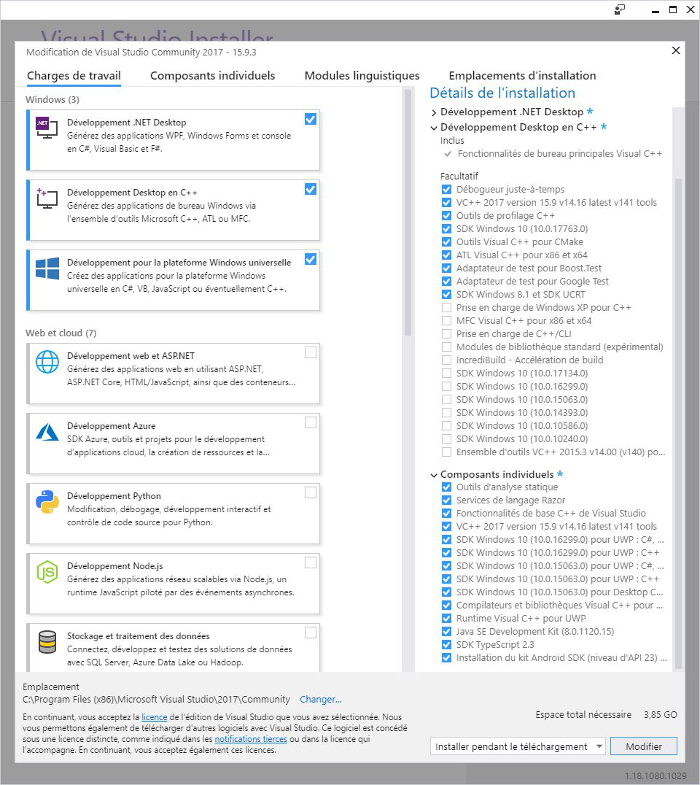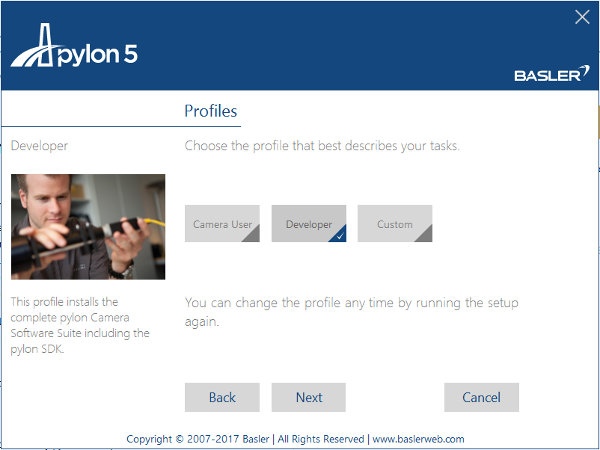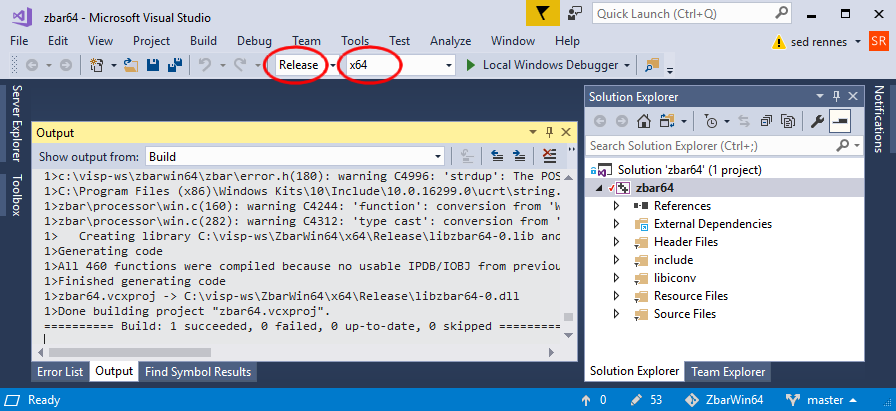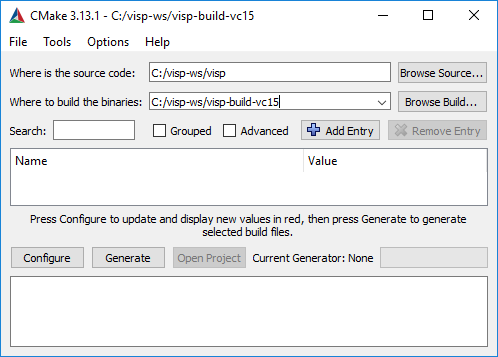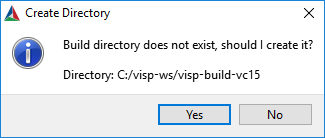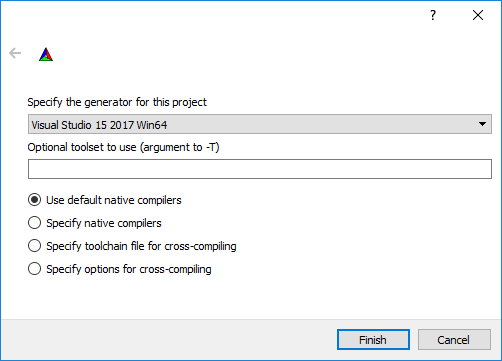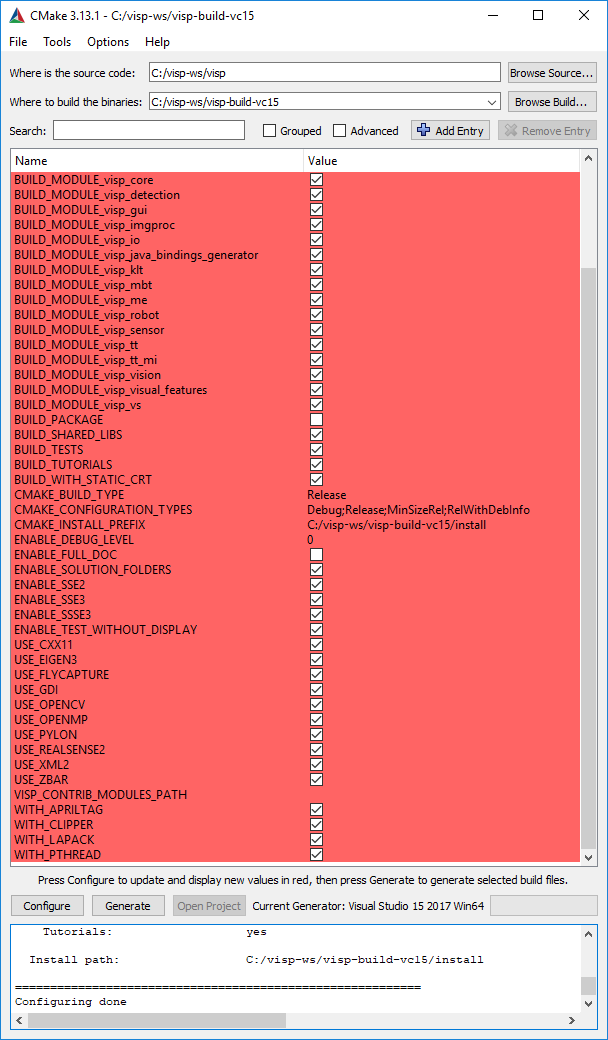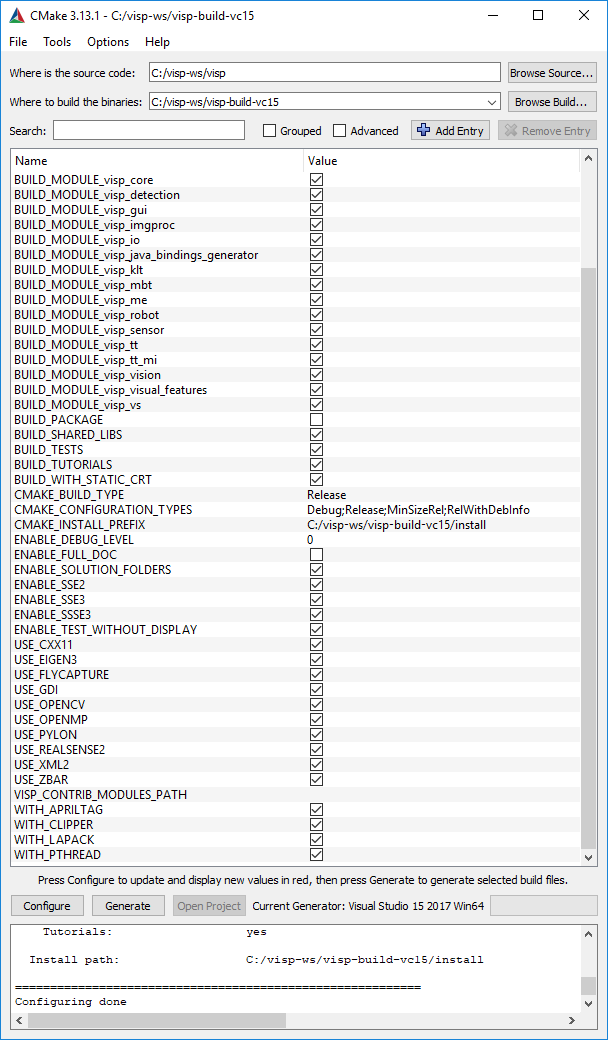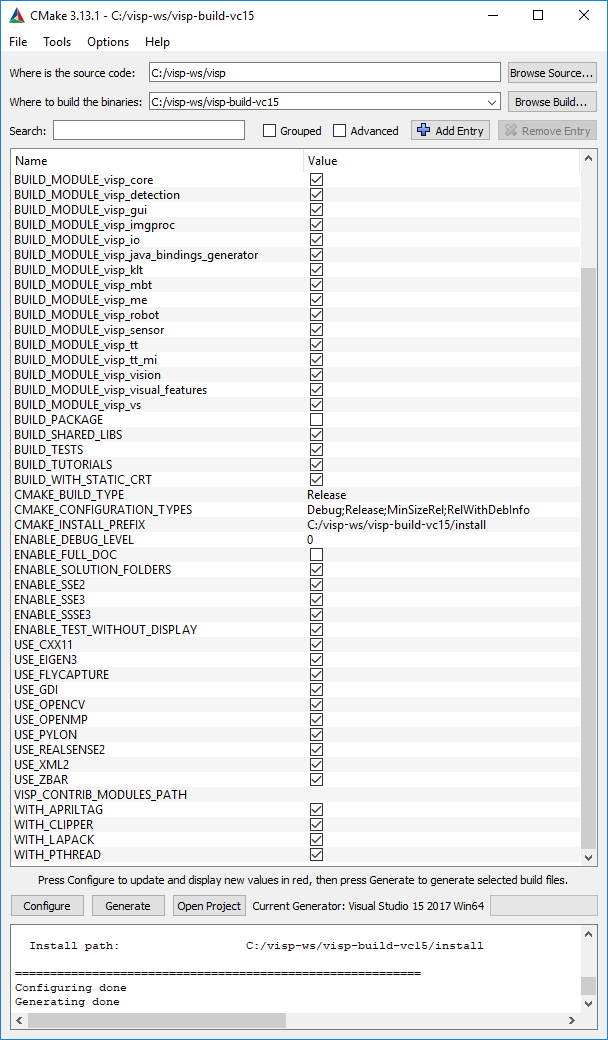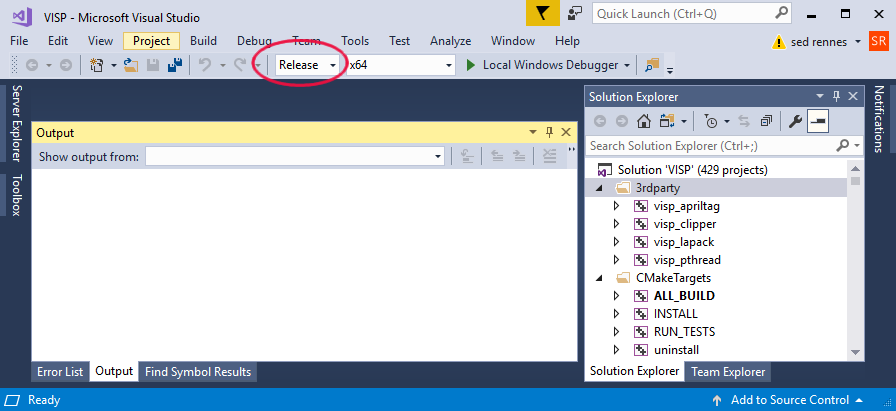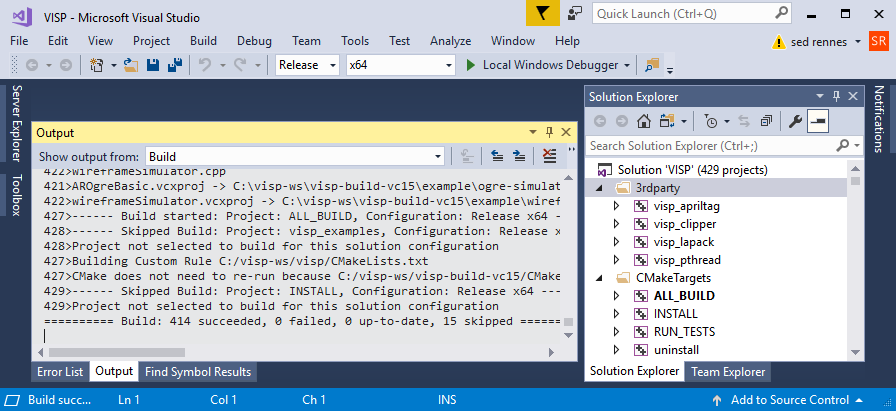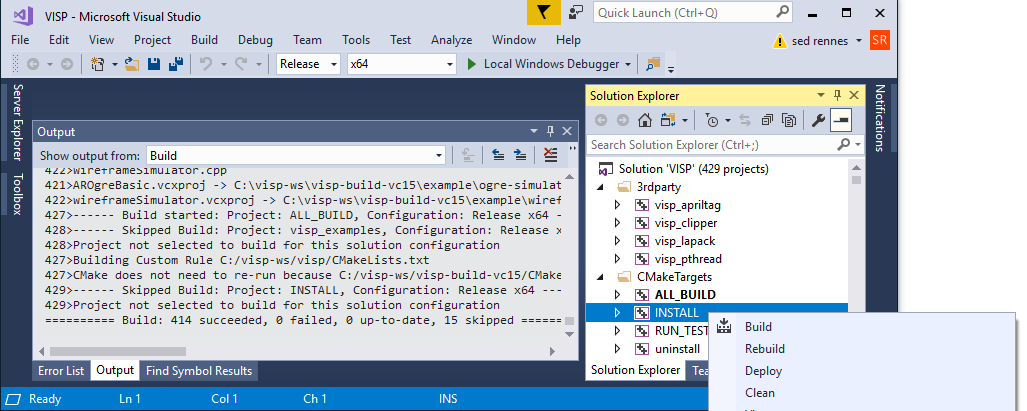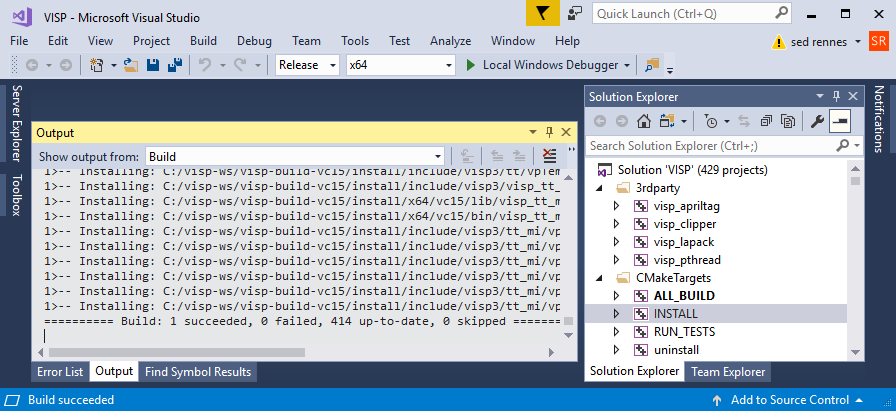In this tutorial you will learn how to install ViSP from source on Windows 10 with Visual C++. These steps have been tested on Windows 10 (64 bit), with CMake 3.13.1 and Visual Studio Community 2017.
- Note
- Concerning ViSP installation, we provide also other Tutorials.
Install prerequisites
Visual Studio
Visual Studio Community 2017 could be downloaded from https://www.visualstudio.com/downloads/. During a fresh installation enable "Desktop development with C++" workload to get "Windows 10 SDK". This SDK allows usage of the Graphical Device Interface (GDI) useful to display images in a window thanks to vpDisplayGDI class. After a fresh installation, start Visual Studio and create an empty C++ project to install the common tools for Visual C++ 2017.
If you already have Visual Studio Community 2017, you can check if "Desktop Development with C++" workload is activated and if "Windows 10 SDK" is enabled following instructions given here that we resume:
- Find the Visual Studio Installer on your computer. Select Start, and then scroll to the letter V, where it's listed as Visual Studio Installer
- Click or tap to start the installer, and then choose "Modify"
- From the Workloads screen, check if "Desktop Development with C++" workload is activated and if "Windows 10 SDK" is enabled like in the following image
- Choose Modify again.
- After the new workloads and components are installed, choose Launch.
CMake
CMake could be download from http://www.cmake.org. Download the latest release for Windows win64-x64 platform (at the time this tuto was written it was the file cmake-3.13.1-win64-x64.msi). To install just double click on the msi file.
Git
Install Git for Windows from https://git-for-windows.github.io/. This installation allows then to use git in a cmd Command Prompt.
Create a workspace
If not already done, create a workspace that will contain all ViSP source, build, data set and optional 3rd parties. This workspace is here set to C:\visp-ws folder, but it could be set to any other location.
To create the workspace, open a cmd Command Prompt (a fast way to launch this window is to press the Win + R keys on your keyboard. Then, type cmd or cmd.exe and press Enter or click/tap OK) and run the following to create a workspace environment var named VISP_WS:
C:\> setx VISP_WS "C:\visp-ws"
C:\> exit
Open a new cmd Command Prompt and create the corresponding folder
C:\> mkdir %VISP_WS%
C:\> exit
Quick ViSP installation
In this section, we give minimal instructions to build ViSP from source just to try ViSP without entering in Advanced ViSP installation.
- Open a new
cmd Command Prompt and get ViSP source code in the workspace C:\> cd %VISP_WS%
C:\> git clone https:
- Create a build directory
C:\> mkdir %VISP_WS%\visp-build-vc15
C:\> cd %VISP_WS%\visp-build-vc15
- Run CMake in build directory (here the generator is chosen for Visual Studio 15 2017 and 64 bits hardware):
C:\> cmake -G "Visual Studio 15 2017 Win64" %VISP_WS%\visp
- Build and install ViSP (installation doesn't need administrator privileges)
C:\> cmake --build . --config Release --target install
- ViSP is now installed in
%VISP_WS%\visp-build-vc15\install folder
- Modify the
Path var to add %VISP_WS%\visp-build-vc15\install\x64\vc15\bin corresponding to the path to ViSP libraries.
- Set
VISP_DIR var to help CMake to find ViSP as a 3rd party C:\> setx VISP_DIR "%VISP_WS%\visp-build-vc15\install"
C:\> exit
- Note
- Since
setx command is not able to handle a var that has more than 1024 characters (which could be the case of Path var), to modify Path environment variable do the following:
- Open the Start Search, type in "env", and choose "Edit environment variables for your account"
- Click the "Environment Variables..." button
- Under the "User Variables" section (the upper half), find the row with "Path" in the first column, and click edit
- The "Edit environment variable" UI will appear.
- Click "New" button to add a new line with
%VISP_WS%\visp-build-vc15\install\x64\vc15\bin
To have a trial, just jump to Install ViSP data set before running some binaries that you just build or jump to Next tutorial. You can later come back to the Advanced ViSP installation.
Advanced ViSP installation
Install 3rd parties
ViSP is interfaced with several 3rd party libraries. The complete list is provided here. We recommend to install OpenCV 3rd party and libxml2 3rd party in the workspace. If you have an Intel Realsense depth camera you may also install librealsense 3rd party. If your camera is a PointGrey you may install FlyCapture 3rd party, while if your camera is a Basler, you may rather install Pylon 3rd party. If you want to be able to detect a QR code you may install zbar 3rd party. To use optimized matrix operations you may install eigen 3rd party. Other 3rd parties are optional and should be considered only by expert developers.
OpenCV 3rd party
1. Get OpenCV
First you have to get OpenCV:
- From http://opencv.org/releases.html download the latest OpenCV for Windows. In our case we got
opencv-4.0.0-vc14_vc15.exe Win pack installer. The same procedure could be applied with the previous OpenCV 3.4.0 release downloading opencv-3.4.0-vc14_vc15.exe.
- Extract the content of the archive in your workspace
%VISP_WS%.
- The installer extract all the material in
%VISP_WS%\opencv.
- We strongly recommend to rename this folder to a name that contain OpenCV version like
%VISP_WS%\opencv-4.0.0.
- Note
- OpenCV 4.0.0 win pack installer contains prebuild OpenCV libraries build with Visual Studio 14 2015 Win64 (vc14) and Visual Studio 15 2017 Win64 (vc15). These libraries are located in
%VISP_WS%\opencv-4.0.0\build\x64\vc14 and %VISP_WS%\opencv-4.0.0\build\x64\vc15 respectively.
2. Complete OpenCV installation
Now you have to complete OpenCV installation setting some environment vars:
- In order that ViSP detects OpenCV you have to set
OpenCV_DIR environment variable. Start up a cmd Command Prompt and enter: C:\> setx OpenCV_DIR "%VISP_WS%\opencv-4.0.0\build"
C:\> exit
%VISP_WS%\opencv-4.0.0\build is where you have installed OpenCV. Inside this folder you should have a file named OpenCVConfig.cmake.
- You have also to add the location of OpenCV libraries corresponding to Visual Studio 15 2017 Win64 usage in the
Path environment variable. Open the "Edit environment variable" UI, and modify Path to add a new line with %VISP_WS%\opencv-4.0.0\build\x64\vc15\bin.
libxml2 3rd party
1. Get libxml2
- Download the latest libxml2 release from ftp://xmlsoft.org/libxml2. At the time this tuto was written it was
libxml2-2.9.8.tag.gz file.
- Extract the content of the tarball in your worksapce
%VISP_WS%. Winrar could be used to this end.
- Here we suppose that you have libxml2 source code in
%VISP_WS%\libxml2-2.9.8 folder.
2. Build and install libxml2 from source
- In the Windows "Start" menu, scroll to "Visual Studio 2017", and select "Visual Studio Command Prompt for native x64".
- To build libxml2 from source enter the following instructions in the Visual Studio Command Prompt:
C:\> cd %VISP_WS%\libxml2-2.9.8\win32
C:\> cscript configure.js iconv=no ftp=no http=no compiler=msvc prefix=%VISP_WS%\libxml2-2.9.8\build-vc15
C:\> nmake /f Makefile.msvc install
- After these steps, libxml2 library could be found in
%VISP_WS\libxml2-2.9.8\build\vc15\bin\libxml2.dll
3. Complete libxml2 installation
- To complete the installation, set
XML2_DIR environment variable: C:\> setx XML2_DIR "%VISP_WS\libxml2-2.9.8\build-vc15"
C:\> exit
- You have also to add the location of libxml2 library in the
Path environment variable. Open the "Edit environment variable" UI, and modify Path to add a new line with %VISP_WS%\libxml2-2.9.8\build-vc15\bin.
librealsense 3rd party
I you have an Intel RealSense Depth camera (SR300 or D400 series), you may install librealsense 2.x in order to use vpRealSense2 class. Otherwise you can skip this section.
Installation instructions are given in the tutorial. We recall the main steps here:
1. Get librealsense
- Open a new
cmd Command Prompt and get ViSP source code in the workspace C:\> cd $VISP_WS
C:\> git clone https:
2. Build and install librealsense from source
- Create a build directory
C:\> mkdir %VISP_WS%\librealsense\build-vc15
C:\> cd %VISP_WS%\librealsense\build-vc15
- Run CMake in build directory (here the generator is chosen for Visual Studio 15 2017 and 64 bits hardware and installation folder is set to the build folder):
C:\> cmake -G "Visual Studio 15 2017 Win64" %VISP_WS%\librealsense -DCMAKE_INSTALL_PREFIX=%VISP_WS%\librealsense\build-vc15
- Build and install librealsense (installation doesn't need administrator privileges)
C:\> cmake --build . --config Release --target install
- librealsense is now installed in
%VISP_WS%\librealsense\build-vc15 folder
3. Complete librealsense installation
- To complete the installation, set
REALSENSE2_DIR environment variable: C:\> setx REALSENSE2_DIR "%VISP_WS\librealsense\build-vc15"
C:\> exit
- You have also to add the location of librealsense library in the
Path environment variable. Open the "Edit environment variable" UI, and modify Path to add a new line with %VISP_WS%\librealsense\build-vc15\bin.
FlyCapture 3rd party
I you have a PointGrey or FLIR USB 2.0, USB 3.0, GigE or FireWire camera (DragonFly2, Flea3...), you may install FlyCapture. Otherwise you can skip this section.
Complete installation instructions are given here. We recap hereafter the main instructions to install FlyCapture SDK under Windows:
- Download the latest FlyCapture2 Full SDK for your camera from Point Grey’s download site. On the download page, select your product family and "Windows 10 64 bit" as operating system. At the time this tutorial we written we selected "FlyCapture 2.11.3.164 SDK - Windows (64 bit)" to download
FlyCapture_2.11.3.164_x64.exe file.
- Double-click the downloaded software executable and follow the installation instructions.
- Select the correct driver for the camera when prompted by the installation instructions.
- Reboot the system.
Pylon 3rd party
I you have a Basler FireWire, Camera Link, GigE or USB3.0 camera, you may install Pylon SDK. Otherwise you can skip this section.
To install Pylon:
- visit Basler Software Download page to download and install the SDK corresponding to your platform. At the time this tutorial we written we selected "Pylon 5.0.11 Camera Software Suite Windows" to download
Basler_pylon_5.0.11.10913.exe file.
- Double-click on downloaded file and follow the installation instructions.
- Be carreful to select "Developer" profile during the installation in order to install Pylon SDK headers (.h) besides the dll.
- Click then on "Next" button.
- Select how your Basler camera is connected to the computer (USB, GigE, FireWire, Camera Link), then click on "Next" button.
- Keep the default destination folder as
C:\Program Files\Basler\pylon 5\ and click on "Next" button
- In the "Ready to install" panel, click on the "Install" button
- Reboot the system.
zbar 3rd party
If you want to work with QR codes (see Tutorial: Bar code detection), we recommend to install zbar 3rd party. Otherwise you can skip this section.
- Note
- Since ViSP 3.1.0 we provide also AprilTag detection capabilities that are available without 3rd party installation (see Tutorial: AprilTag marker detection).
To install zbar you need to build the library from source. There is a fork of the library available from GitHub (https://github.com/dani4/ZBarWin64) and adapted for compiling under Visual following the steps:
1. Get zbar
- Get ZBarWin64 source code from Github repository. To this end open a
cmd Command Prompt and hit: C:\> cd %VISP_WS%
C:\> git clone https:
2. Build zbar from source
- Then open
%VISP_WS%\ZBarWin64\zbar64.sln solution file with Visual Studio C++
- Select
"Release" and "x64" configuration. Then to build zbar library enter menu "Build \> Build Solution" or hit "Ctrl+Shift+B".
3. Complete zbar installation
- To complete the installation, set
ZBAR_DIR environment variable: C:\> setx ZBAR_DIR "%VISP_WS%\ZBarWin64"
C:\> exit
- You have also to add the location of zbar and iconv libraries in the
Path environment variable. Open the "Edit environment variable" UI, and modify Path to add 2 new lines, one with %VISP_WS%\ZBarWin64\x64\Release, another with %VISP_WS%\ZBarWin64\zbar\libiconv\dll_x64.
eigen 3rd party
Even if eigen is designed as a template we recommend to install the library with Visual Studio.
1. Get eigen
- Download the latest eigen release from http://eigen.tuxfamily.org. At the time this tutorial was written we downloaded
eigen-eigen-b3f3d4950030.tar.gz tarball corresponding to eigen 3.3.5.
- Extract the content of the archive in
%VISP_WS%.
- We recommend to rename
%VISP_WS%\eigen-eigen-b3f3d4950030 in %VISP_WS%\eigen-3.3.5
2. Build and install eigen from source
- Create a build directory
C:\> mkdir %VISP_WS%\eigen-3.3.5\build-vc15
C:\> cd %VISP_WS%\eigen-3.3.5\build-vc15
- Run CMake in build directory (here the generator is chosen for Visual Studio 15 2017 and 64 bits hardware and installation folder is set to
%VISP_WS%\eigen-3.3.5\build-vc15\install folder): C:\> cmake -G "Visual Studio 15 2017 Win64" %VISP_WS%\eigen-3.3.5 -DCMAKE_INSTALL_PREFIX=%VISP_WS%\eigen-3.3.5\build-vc15\install
- Build and install eigen (installation doesn't need administrator privileges)
C:\> cmake --build . --config Release --target install
- eigen is now installed in
%VISP_WS%\eigen-3.3.5\build-vc15\install folder
3. Complete eigen installation
Now you have to complete eigen installation setting some environment vars:
- In order that ViSP detects eigen you have to set
EIGEN_DIR environment variable. Start up a cmd Command Prompt and enter: C:\> setx Eigen3_DIR "%VISP_DIR%\eigen-3.3.5\build-vc15\install"
C:\> exit
%VISP_DIR%\eigen-3.3.5\build-vc15\install is where you have installed eigen. Inside this folder you should have a file named Eigen3Config.cmake.
- There is no need to set
Path environment var since eigen is a template that has no library.
Get ViSP source code
There are different ways to get ViSP source code.
- You can download the latest release as a zip or a tarball. Once
visp-x.y.z.tar.gz or visp-x.y.z.zip is downloaded, uncompress the file in %VISP_WS%\visp\visp-x.y.z using for axample WinRAR.
- You can also download a daily snapshot. Once visp-snapshot-yyyy-mm-dd.tar.gz is downloaded, uncompress the file in
%VISP_WS%\visp\visp-x.y.z using for axample WinRAR.
- Or you get the cutting-edge ViSP from GitHub repository using the
git command line tool: C:\> cd %VISP_WS%
C:\> git clone https:
We suppose now that ViSP source is in %VISP_WS%\visp.
Configure ViSP from source
The goal of the configuration step is now to use CMake to produce a Visual Studio C++ solution file that will be located in %VISP_WS%/visp-build-vc15.
- Launch CMake (cmake-gui) and complete the source code and binaries location as in the next image.
- Click then on "Configure" button.
- Click on "Yes" to create the
%VISP_WS%/visp-build-vc15 folder.
- Select then your compiler "Visual Studio 15 2017 Win64" and click on "Finish" button.
- This will start CMake configuration. As shown in the next image, Eigen, Flycapture, GDI (Graphical Device Interface), OpenCV, OpenMP, Pylon, Realsense, XML2 and Zbar 3rd parties are automatically detected.
- Note
- Installation folder is set to
%VISP_WS%/visp-build-vc15/install. If you want to change the installation folder to C:\Program Files (x86)\ViSP, make sure that you have administrator privileges to write in that folder before modifying CMAKE_INSTALL_PREFIX.
- Click then on "Configure" button. All the red lines should disappear.
- Note
- The default configuration lead to the creation of a shared library (with
.dll extension). This is the default configuration that is recommended. If you want to create rather a static library (with .lib extension) you have to uncheck the BUILD_SHARED_LIBS option to disable DLL creation.
- To finish the configuration, click on "Generate" button.
- Once the generation is done, in
%VISP_WS%/visp-build-vc15 folder you have the Visual Studio VISP.sln generated solution file.
Build and install ViSP libraries
- To build ViSP just double click on
%VISP_WS%/visp-build-vc15/VISP.sln solution file. This action will open ViSP project in Visual Studio C++. By default, Visual Studio opens the solution in Debug configuration. Modify the configuration to "Release".
- Enter menu
"Build \> Build Solution" to build ViSP or hit "Ctrl+Shift+B".
- At the end of the build process you should have the following indicating that all the build succeeded.
- Now to install ViSP, build
"INSTALL" project. To this end, apply a left click on "INSTALL" to select the project, then a right click to enter in the "Build" menu.
- At the end of the installation, you should have the following.
- As shown in the previous image, all the headers but also the generated libraries are copied in
%VISP_WS\visp-build-vc15\install folder; headers and libraries in include and x64/vc15 subfolders respectively.
- This ends ViSP installation in
"Release" configuration. Now in %VISP_WS%/visp-build-vc15/install/x64/vc15/bin folder you have ViSP DLL libraries corresponding to ViSP modules.
- Note that you can also build ViSP in
Debug configuration. In that case, all the library names are suffixed by "d" character (libvisp_core320d.dll...).
Set Path environment var
Modify the Path var to add the path to ViSP dll libraries. To this end open the "Edit environment variable" UI, and modify Path to add a new line with %VISP_WS%\visp-build-vc15\install\x64\vc15\bin.
Set VISP_DIR environment var
In order to ease ViSP detection by CMake when ViSP is used as a 3rd party in an external project, like the one described in the Tutorial: How to create and build a CMake project that uses ViSP on Unix or Windows, you may set VISP_DIR environment variable with the path to the VISPConfig.cmake file:
C:\> setx VISP_DIR "%VISP_WS%\visp-build-vc15\install"
C:\> exit
Install ViSP data set
Some ViSP examples and tests require data (images, video, models) that are not part of ViSP source code but available in a separate archive named visp-images-x.y.z.zip. This archive could be downloaded from http://visp.inria.fr/download page. We provide here after the way to install these data if you want to run ViSP examples or tests. Note that ViSP tutorials are not using ViSP data set.
- Download
visp-images-3.2.0.zip from https://visp.inria.fr/download and uncompress it in your workspace %VISP_WS%.
- ViSP examples and tests are able to detect automatically the location of the requested data if you position an environment variable called
VISP_INPUT_IMAGE_PATH. In our case, this variable should be set to %VISP_WS%\visp-images-3.2.0. Open a cmd Command Prompt and run C:\> setx VISP_INPUT_IMAGE_PATH %VISP_WS%\visp-images-3.2.0
C:\> exit
- From now, you can try to run ViSP examples and tests. For example, if you want to run
%VISP_WS%\visp-build-vc15\example\device\display\Release\displayGDI.exe, open a cmd Command Prompt, enter in the right folder and run: C:\> cd %VISP_WS%\visp-build-vc15\example\device\display\Release
C:\> displayGDI.exe
A click to close the windows...
A click to display a cross...
Cross position: 392, 306
A click to exit the program...
Bye
Tips and tricks
How to take into account a newly installed 3rd party
Since all 3rd parties are optional you may have started to install only some of them. Imagine that you just installed a new third-party, or that you upgraded the version of this 3rd party. The next step is to go back to the build folder, configure ViSP with CMake to detect the newly installed third-party library and build again ViSP. This could be achieved with:
$ cd $VISP_WS/visp-build-msvc15
$ cmake ../visp
Here you can check the content of the ViSP-third-party.txt file and see if the newly installed 3rd party is well detected.
Finally, you need to rebuild and install ViSP with:
$ cmake --build . --config Release --target install
How to uninstall ViSP
After ViSP installation, you can remove installed material using:
$ cd $VISP_WS/visp-build-msvc15
$ cmake --build . --config Release --target uninstall
How to build only ViSP libraries
If you want to build only ViSP modules libraries, nor the examples, tutorials and tests:
$ cd $VISP_WS/visp-build-msvc15
$ cmake --build . --config Release --target visp_modules
How to build a ViSP specific module
If you want to build a given module and all the dependencies:
$ cd $VISP_WS/visp-build-msvc15
$ cmake --build . --config Release --target visp_<module_name>
For example to build the model-based tracker module named mbt, run:
$ cd $VISP_WS/visp-build-msvc15
$ cmake --build . --config Release --target visp_mbt
Which are the 3rd party libraries that are used in ViSP ?
To see which are the optional 3rd parties that are found during the configuration stage and that will be used by ViSP during the build you can have a look to the text file named ViSP-third-party.txt and located in $VISP_WS/visp-build. We provide hereafter an example of a possible content of this file that contains also build info.
$ type $VISP_WS/visp-build/ViSP-third-party.txt
==========================================================
General configuration information for ViSP 3.2.0
Version control: 3.1.0-690-geb7c0779c
Platform:
Timestamp: 2018-12-05T09:33:04Z
Host: Windows 10.0.15063 AMD64
CMake: 3.13.1
CMake generator: Visual Studio 15 2017 Win64
CMake build tool: C:/Program Files (x86)/Microsoft Visual Studio/2017/Community/MSBuild/15.0/Bin/MSBuild.exe
MSVC: 1911
C/C++:
Built as dynamic libs?: yes
C++ Compiler: C:/Program Files (x86)/Microsoft Visual Studio/2017/Community/VC/Tools/MSVC/14.11.25503/bin/HostX86/x64/cl.exe (ver 19.11.25547.0)
C++ flags (Release): /DWIN32 /D_WINDOWS /W3 /GR /EHsc /MP4 /EHa -openmp -
std=c++11 /MD /O2 /Ob2 /DNDEBUG
C++ flags (Debug): /DWIN32 /D_WINDOWS /W3 /GR /EHsc /MP4 /EHa -openmp -
std=c++11 /MDd /Zi /Ob0 /Od /RTC1
C Compiler: C:/Program Files (x86)/Microsoft Visual Studio/2017/Community/VC/Tools/MSVC/14.11.25503/bin/HostX86/x64/cl.exe
C flags (Release): /DWIN32 /D_WINDOWS /W3 /MP4 /EHa -openmp -
std=c++11 /MD /O2 /Ob2 /DNDEBUG
C flags (Debug): /DWIN32 /D_WINDOWS /W3 /MP4 /EHa -openmp -
std=c++11 /MDd /Zi /Ob0 /Od /RTC1
Linker flags (Release): /machine:x64 /INCREMENTAL:NO
Linker flags (Debug): /machine:x64 /debug /INCREMENTAL
ViSP modules:
To be built: core gui imgproc io java_bindings_generator klt me sensor ar blob robot visual_features vs vision detection mbt tt tt_mi
Disabled: -
Disabled by dependency: -
Unavailable: java
Windows RT support: no
Python (for build): NO
Java:
ant: NO
JNI: C:/Program Files/Java/jdk1.8.0_131/include C:/Program Files/Java/jdk1.8.0_131/include/win32 C:/Program Files/Java/jdk1.8.0_131/include
Build options:
Build deprecated: yes
Build with moment combine: no
Mathematics:
Use Lapack/blas: no
Use Lapack (built-in): yes (ver 3.2.1)
Use Eigen3: yes (ver 3.3.5)
Use OpenCV: yes (ver 4.0.0)
Use GSL: no
Simulator:
Ogre simulator:
\- Use Ogre3D: no
\- Use OIS: no
Coin simulator:
\- Use Coin3D: no
\- Use SoWin: no
\- Use SoXt: no
\- Use SoQt: no
\- Use Qt4: no
\- Use Qt3: no
Media I/O:
Use JPEG: no
Use PNG: no
\- Use ZLIB: no
Use OpenCV: yes (ver 4.0.0)
Real robots:
Use Afma4: no
Use Afma6: no
Use Franka: no
Use Viper650: no
Use Viper850: no
Use aria (Pioneer): no
Use PTU46: no
Use Biclops PT: no
Use Virtuose: no
GUI:
Use X11: no
Use GTK: no
Use OpenCV: yes (ver 4.0.0)
Use GDI: yes
Use Direct3D: no
Cameras:
Use DC1394-2.x: no
Use CMU 1394: no
Use V4L2: no
Use directshow: no
Use OpenCV: yes (ver 4.0.0)
Use Flycapture: yes (ver )
Use Pylon: yes (ver 5.0.11)
RGB-D sensors:
Use Realsense: no
Use Realsense2: yes (ver 2.17.0)
Use Kinect: no
\- Use libfreenect: no
\- Use libusb-1: no
\- Use pthread: no
Use PCL: no
\- Use VTK: no
F/T sensors:
Use atidaq (built-in): no
Use comedi: no
Detection:
Use zbar: yes (ver 0.10.1)
Use dmtx: no
Use AprilTag (built-in): yes (ver 0.9.8)
Misc:
Use Clipper (built-in): yes (ver 6.4.2)
Use XML2: yes (ver 2.9.4)
Optimization:
Use OpenMP: yes
Use pthread: no
Use pthread (built-in): yes (ver 2.9.1)
Use cxx11: yes
cxx standard: 11
Documentation:
Use doxygen: yes
Tests and samples:
Tests: yes
Demos: yes
Examples: yes
Tutorials: yes
Install path: C:/visp-ws/visp-build-vc15/install
==========================================================
Next tutorial
You are now ready to see the next Tutorial: How to create and build a CMake project that uses ViSP on Unix or Windows that will show you how to use ViSP as a 3rd party to build your own project.


